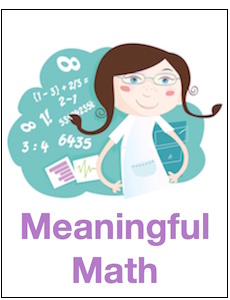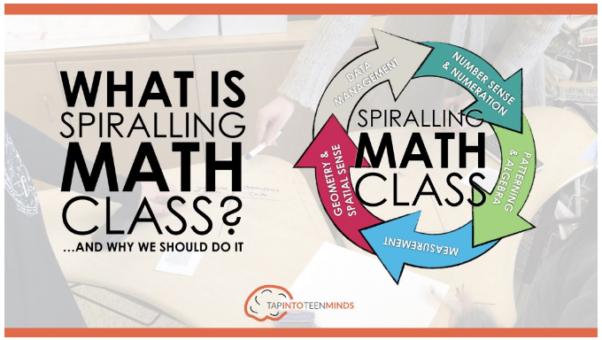How Do I Keep Students from Giving Up on Math?
A MiddleWeb Blog
 Over the Thanksgiving break (yea!) I had a chance to think about my classes and how things are going. Overall, things are fine. However, something a student said right before we left for break has really weighed on my mind.
Over the Thanksgiving break (yea!) I had a chance to think about my classes and how things are going. Overall, things are fine. However, something a student said right before we left for break has really weighed on my mind.
The student said, “Math class is getting hard and math has always been my best class.” (The class was Algebra 2 with Trig.) This is a good student who always gives a good effort. It was troubling because it was obvious that the student was discouraged and was ready to give up.
As I began thinking about it, I realized that it’s not just the one student. I often hear things like, “I just can’t do math” or “it’s too hard.” In fact, some students have given up before they get to my class. They ran into some concept in a previous class that they found difficult and it continues to affect them.
Some students can share exactly when “math got hard.” For some, it was when they had to memorize their multiplication tables; for others it was when they had to start using letters in math (their words).
After their particular event, they struggled to be successful in math class again. They had run into something they’d found difficult and weren’t able to work through it. I think part of the problem is that students’ confidence in math is so tenuous to begin with that they don’t think about a difficult single concept as a challenge to work through. Instead they go straight to “I’m not good at math.” When a student gets to that point, they would rather give up than risk trying and failing.
Am I creating conditions for failure?
So I’ve been thinking: am I setting my students up for failure? I certainly don’t mean to. I try to give every student the support and help they need. But are there things that are going on in my classroom that could contribute to students giving up? It scares me to think that my class could be the class where a student finally just gives up on math.
I know a lot of MiddleWeb readers are middle school math teachers. But much of what I’ve written about in this blog seems to resonate across the secondary grades. I think this is another topic where we all share some basic concerns.

The student quoted earlier was in a class period that faced unique challenges. This class had been interrupted many times over the past few weeks: twice for me to attend professional development, once for state playoffs for the football team, once for an evacuation during a small fire that kept us outside for over the half the period.
It is also my largest class with 30 students. I can’t control the school schedule or the class sizes, but there are things that are under my control. So I started thinking – What can I change in my classroom that will help students keep trying even when they face a setback? How do I help students avoid giving up on math?
Idea 1: Spiraling the Content
This is important because I want students to have another go at the content they struggled with initially. I think it’s discouraging when you don’t get another chance to show that you can do something. I want them to have the opportunity to prove to themselves that they can do it. Also, returning to a topic after a little break can make all the difference. Sometimes students need time to let ideas percolate.
Last year I started trying to spiral content or provide “spaced practice” by assigning homework that addressed content previously learned. I wrote about it in this blog post. As it turned out, I wasn’t able to implement it in a way that I thought was meaningful.
So I have spent a lot of time over my Thanksgiving break researching how to spiral content in my class in a way that is doable and impactful. I’ll be honest, it seems a little overwhelming. I still don’t have it figured out. But I’m determined to make it work, so I’m going to find a way to integrate it successfully into my teaching, and I promise to write about my results later.
Currently, my plan is to start small. In a few weeks, I am going to get everyone up at the board working on a problem that involves the concepts from our unit on quadratics. I hope I will improve in this area as time goes on. If anyone is currently spiraling or interleaving in their math class, please share your ideas and suggestions in the comments!
Resources for spiraling content:
Henri Picciotto’s Math Education Newsletter
The Complete Guide to Spiralling Your Math Curriculum
Idea 2: Allow Retakes on Classroom Tests
I think retakes are valuable, and I use them with good success in my AP Statistics class. I allow a student to take a different version of the test, with the caveat that the test needs to retaken before I give the test for the next unit. That reduces the amount of binders I have to have out at one time. It also gives a timeline for students who may have trouble keeping deadlines. So far I haven’t had any students abuse the opportunity.
I have resisted retakes in my Algebra 2 classes this year because of the sizes of my classes. I usually have a total of about 20 AP Stats students and I have around 100 Algebra 2 students. I worried that allowing retakes in that larger class will be more than I can handle. But if I’m going to give a good faith effort to help my students avoid giving up, I think this is something I need to do. Again, please share your experiences (especially if you have large classes!).
Idea 3: Share Some Personal History
I think what the student I quoted earlier also meant was that math class is getting hard and it had always been easy for her before. I can sympathize. Math came naturally to me, and I loved the logic and the patterns I saw in numbers. Everything was great until long division. It made no sense to me, and I wasn’t interested in figuring it out.
I began to wonder if I had ever really been good at math to start with. I won’t lie, long division was a long drawn-out affair until I finally got it. Looking back I wouldn’t call any of it easy or fun. I had got to my “hard part” and I wanted to give up.
Fortunately I had a teacher who was willing to work with me to get past my sense of failure. I remember a lot of patient one-on-one help and kind encouragement. By telling my own story and sharing the experiences of others, I hope I can help students avoid the trap of thinking, “I might as well give up, I’m not good at math anyway.” Everyone runs into a concept that they find difficult; it does not define you as a math student.
Idea 4: Make Sure Students Have an Adequate Foundation
Math success requires prerequisite knowledge. Constantly lacking the tools you need to solve problems would make anyone want to give up. For the current Quadratic Functions unit, prerequisite skills include factoring trinomials and multiplying binomials. I knew students weren’t strong in this area, but I was unaware of the degree they struggled. I did not adequately address the skills they needed to be successful.
As usual I was fighting a battle with pacing and time. I thought we would be able to address the gaps as we went, and it ended up discouraging some of the students. So, in the future, no cutting corners. If I know students need extra time for foundational skills, I’m going to give it to them.
I want students to leave my class with more math confidence than they had to start with – not defeated and thinking that “it’s just too hard.” Even though I’m a little daunted by the amount of work that it’s going to take to implement my plan, I’m going to try.
It certainly all won’t happen this year. But I think it’s a good plan. I’m sure with more research (Twitter, here I come!) and some input from other teachers, I can make key changes that will do some good. Please share how you’ve kept students from giving up in your math class!





































I’m not a math person, but these strike me as helpful ideas. Readers might also be interested in my post “17 Ideas to Combat Learned Helplessness” here: https://www.middleweb.com/33614/17-ideas-to-help-combat-learned-helplessness/
I love your suggestions! I think they would work in any classroom. In particular, I liked your suggestions regarding how to avoid giving students, “a get out of work free” option and how to set the stage for cold calling. I’m going to refer to back to your post repeatedly in the next few months to help me!
I too had problems with certain sections of Algebra 2. I required more practice and that’s what it takes. Study guides are sold at bookstores or can be checked out from a public library. One Hundred problems during a Christmas break—that’s what it may take! Science classes can be the same. Some of it takes brute memorization. The availability of on-line resources can be a huge help. Also another student as a tutor is very helpful.
Thank you for your comment! I think you’re right, sometimes we run into topics that require more work and practice on our part. Students need to be prepared for that to happen. Memorization and practice are not usually fun, but we all have to do it sometimes.
I teach ELA, and I can see these ideas as cross-curricular. I really needed to hear these ideas tonight. Thank you for posting!
Thank you for your comment!
I agree completely with the steps that you are taking to help students find success. All of them will help students become more successful. Building confidence is a large part of the equation. Math is a subject where almost every person reaches a point where they struggle. For some this is fractions, algebra, geometry, trig, calculus or even higher level courses. Unfortunately, as parents this is what they remember, there last math class. As teachers we are all guilty of not wanting our students to struggle and we jump in to make it easy. Spoon-feeding is to provide someone with so much help or information that they do not need to think for themselves.Instead of spoon feeding students help students to realize that making mistakes and struggle is an important step in learning. This is a component of a growth mindset promoted by Carol Dweck and Jo Boaler. Here are some thoughts related to struggle. Help students learn that when you struggle is when your brain grow. @joboaler We want to be as least helpful to students to the point short of where they don’t die. @robertkaplinsky When students struggle only ask questions that do not give away the answer. @gfletchy
Students struggle in many other areas, sports, preforming arts, and video games. With these they learn that FAIL means First Attempt in Learning. Practice, persistence, patience, and hard work are what makes them successful. With video games all students fail but they do not give up they start again and learn from their mistakes. Unfortunately students do not connect what happens outside of the classroom with what would also work in the classroom. Matt Larsen, NATM past president, said that students need to expend energy to learn.
If you are interested in more information about developing a growth mindset visit http://bit.ly/lennyvgrowth
Your instincts are sound here – these steps should help. Sarah Tantillo’s article on “learned helplessness” (mentioned in her comment above) is a good resource, too. Students who are used to “getting it” without much struggle might be especially vulnerable to the urge to blame themselves when they suddenly hit a brick wall. Telling the story of your own persistence might help a lot! I’d guess most of them see you as a person to whom math has always come easy. :)
We have middle school classes of 35 and the math teachers have offered reassessments for years. We build them into our schedules – students can come before or after school, as well as during lunch. Sometimes we have “amnesty” day where students can retake assessments and catch up on missing work. The other thing that makes it easier on us is that we grade by standard, so the students don’t have to retake the ENTIRE exam, just the standards that they did not master. It makes the time needed for reassessment much shorter and lessens the stress on the students and on us!
Wow! Those are great ideas!!! It seems like standard based grading and reassessment go together well. That is definitely something I need to think about. I also like your “amnesty” day. Thank you!!!
I teach 6th grade math. Students may only retake tests if they score a C or below on the original. They only retake the questions they missed. They must attend a “reteach” session before they can retake.
My son is in HS. Only allowed to retake if original is D or F. Must meet with teacher first to go over concepts. Maximum score for new grade is D+ (69%).
The Go Math curriculum does a great job with Spiral Review. Four questions with previously learned concepts on each homework assignment. Go Math also has a “Show What You Know” online section that can I assign as homework. It’s sort of like a pre-test to make sure that all students have the necessary skills to start the next chapter. If they get a problem wrong, they can try again, with assistance from the program if necessary. Most students score 100%, since they can keep trying/learning until they get the concept right. I don’t have to grade it, since it’s online.
I haven’t heard of Go Math, but it sounds great. I especially like the spiral review. I looked at the Go Math website briefly and it looked really good. I wish they had curriculum for high achool. Thanks for your comment!
I offer retakes to all of my math classes, Algebra 2 included. I have very few students who take advantage of the opportunity, but part of what I do supports mastery without a retake. All of my students are required to write test corrections, which are a separate grade from the test itself. They redo the work for the question and write an explanation that explains the changes/processes that corrected the errors they made on the test. If, after they complete the corrections, they would like to take a retake, they make that request of me. If I believe, through their test corrections or a conversation with the student that they would score better on a retake than they did on the original test, I let them retake it. If I’m not sure, I require the student to meet with me to go over the concepts I’m not sure they’ve improved on. My rule is that the retake grade stands, better or worse, which reduced the number of students who take a retake because they must be absolutely sure they have a better understanding and I must approve it. This has kept retakes manageable. On the other had, grading test corrections is a bear, and I don’t have anywhere close to 100 math students. Perhaps you could make test corrections an in-class activity that would allow for both collaboration between students and learning from mistakes.
Thank you so much for your comment! I do the same thing with my retakes, the last grade stands.
I like that you evaluate the students individually after their test corrections to see if they are good candidates for a retake. Your comment is making me realize that I need to be more efficient when grading and evaluating test corrections. I think your idea about collaborating with other students to complete test corrections is a really good one. Thank you, you’ve given me alot of ideas!
I do test corrections for all my classes. Sometimes it is done in groups, sometimes individually. The students can use their books and notes.
Thanks for your comment! I do my test corrections the same way. I think allowing students to work in groups, and being allowed to use their books and notes is a good idea. If a student missed a problem on a test a few days earlier, it’s not reasonable to think they would be able to complete a correction without some sort of help.
We started giving test corrections years ago to help those kids who were failing pass, to allow them to not have to retake the class with a max score of 70%. That turned into everyone being allowed to retake tests as a school which has created a culture of not trying on the first attempt because the philosophy with standards based grading has become does it really matter when they know it so there should be a path back to a 100%.
I never really agreed but have tried many different things. Now, depending on the class I do some different things but this has been a 10 year journey for me. If you would ever like to discuss any part of it or what I am doing now and why I would be happy to talk to you or exchange some emails. Just not enough room here :).
Very interesting! I’m very curious about standards based grading. I have been allowing retakes for three years and the students haven’t abused it so far. At my school whether to allow retakes is decided by each teacher and is not a school wide policy. I think that would make a difference. It sounds like what you are describing could be a lot of work for the teacher. I would be interested in whether this has increased student mastery of the content. Thank you so much for your comment!
Sorry for such a long post:
The publisher of Go Math is Houghton Mifflin Harcourt. hmhco.com
They may publish an HS curriculum that is similar to Go Math. Our ISD did a lot of research on several elementary & MS math curricula, then decided to cooperatively purchase Go Math in order to provide a discount to the districts in the ISD.
I really like the online component of Go Math. I can assign 10 homework problems online & students can get help from software program as needed. Then I assign a 10 problem homework quiz where students cannot get help. I can also assign quiz retakes on the computer. There are different iterations of the problems. Everything is corrected for me. Tests are online. Questions can be randomized & tests password protected by class.
Computer-based homework & student help frees up a lot of my class time to work with struggling students. I do not need to use class time to review or answer questions about last night’s homework assignment.
Spiral Review is not included in online version of homework, only in book version, so I assigned Spiral Review separately each day. Questions in online homework are more rigorous than questions in work/textbook. I don’t like the way Go Math/Think Central grades the tests, so I go back through & reassign points the way I want them….still less time-consuming than grading from scratch. We purchased the 6th grade CC 2015.
Overall, I really like the Go Math curriculum for 6th grade (plus the answers are not in Slader yet).